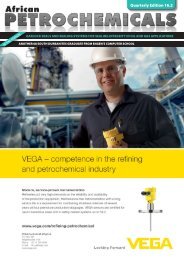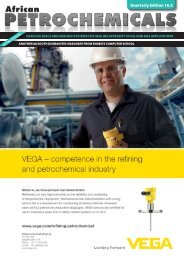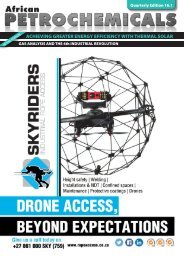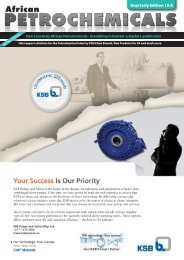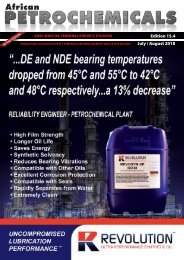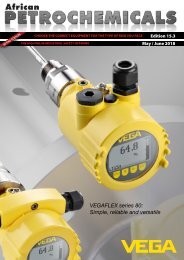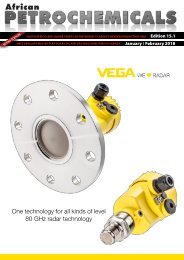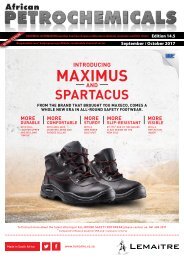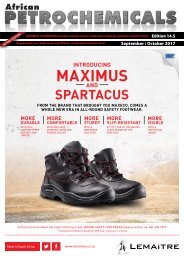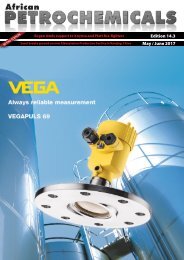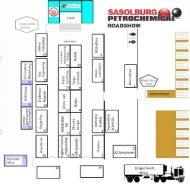African Petrochemicals Edition 16.3
Create successful ePaper yourself
Turn your PDF publications into a flip-book with our unique Google optimized e-Paper software.
IPP & Renewables<br />
THREE MYTHS OF LUBRICATION THAT NEED BUSTING<br />
As specialists in lubrication reliability<br />
solutions, the team at Lubrication<br />
Engineers (LE) South Africa frequently<br />
comes up against myths relating to<br />
lubricants. “People believe things<br />
or are taught things about oils and<br />
greases that are not necessarily<br />
true, and by implementing this bad<br />
advice or outdated practices, they<br />
risk compromising their equipment,”<br />
says Callum Ford, National Marketing<br />
Manager at LE South Africa. “We try<br />
to educate the market about best<br />
practice to help raise the bar and fight<br />
misinformation.”<br />
These are the three most common myths the<br />
company comes up against:<br />
16<br />
1. The colour of a lubricant affects its<br />
efficacy<br />
“We often have people phoning us up and<br />
saying things like, ‘I want the red lubricant<br />
because it’s the best.’ In truth, the colour of a<br />
lubricant is normally something that is added<br />
as a marketing tactic or to differentiate it<br />
from other products – it has no bearing<br />
on the effectiveness of the lubricant itself,”<br />
says Ford. “The most important aspect of<br />
lubrication choice is selecting a product that<br />
is best suited for your particular application.”<br />
Ford explains that LE South Africa uses colour<br />
in its products to differentiate between<br />
product types. Edible lubricants are white;<br />
lithium-based lubricants are yellow; opengear<br />
lubricants are purple and lubricants for<br />
cars and trucks (especially oils) are red. Some<br />
companies, on the other hand, will colour<br />
lubricants to match their brand colours.<br />
2. Grease it until it leaks<br />
Ford says that this line of thinking holds that<br />
greasing machinery with more lubricant<br />
means you will have to re-apply the product<br />
less often. However, overlubricating can<br />
create problems instead of resolving them.<br />
“Overgreasing equipment will mean the<br />
lubricant begins to work against itself,<br />
causing internal friction,” he explains. “This<br />
can lead to temperatures rising in the<br />
machine, seals collapsing, and even eventual<br />
equipment failure. For optimal performance,<br />
you need the right lubricant applied at the<br />
right frequency and in the right dosage.<br />
This is why lubrication schedules are<br />
important, and why many companies are<br />
moving to single-point lubrication systems,<br />
which automatically dispense lubrication<br />
into machinery in optimal quantities at set<br />
intervals.”<br />
3. A grease is a grease<br />
Not all greases are created equal. Some are<br />
the consistency of honey; others of peanut<br />
butter; still others of toffee. Naturally, these<br />
greases will behave differently.<br />
“When it comes to grease viscosity, there’s<br />
a scale created by the National Grease<br />
Lubricating Institute (NLGI) ranging from<br />
000 to 6, representing very low to very high<br />
viscosity greases,” says Ford. “Equipment<br />
manufacturers will specify the NLGI grade<br />
required on the equipment. If it specifies<br />
NLGI 002 and you’re using NLGI 3, you’re<br />
going to run into problems, because the<br />
grease penetration is different.”<br />
Furthermore, even greases with the same<br />
NLGI rating will behave differently depending<br />
on the base and additives with which they<br />
are made. “For example, I use a test machine<br />
we call a ‘rat trap’ to show clients how two<br />
lubricants with the same NLGI grade react<br />
to the same force or pressure over time.<br />
The one lubricant disperses from the joint<br />
where it’s been applied much quicker than<br />
the other, loses its tackiness and heats up far<br />
more quickly. This is why we take the time<br />
to understand what the specific lubrication<br />
application is, and what a customer needs<br />
before we recommend a product. Each of<br />
our unique, proprietary additives has been<br />
designed to yield specific benefits.”<br />
About Lubrication Engineers<br />
Lubrication Engineers (LE) South Africa<br />
represents the LE brand in South Africa,<br />
Botswana, Namibia, Mozambique, Zimbabwe<br />
and Zambia. LE hold the rights to Southern<br />
Africa on the LE brand, recognised<br />
internationally as a specialist in lubrication.<br />
Through LE Incorporated, they are a member<br />
of a worldwide network of companies<br />
spanning Europe, South America, Asia and<br />
Africa, while LE Incorporated operates in the<br />
USA and covers North America including<br />
Canada, Mexico and the USA.<br />
LE provides high performance, heavy-duty,<br />
quality lubricants for virtually every industry<br />
and application, as well as expert technical<br />
back-up and support.<br />
For more information:<br />
www.lubricationengineers.co.za<br />
Contact:<br />
Callum Ford<br />
National Marketing Manager, LE<br />
Tel: 011 464 1735<br />
Email: callum@lubricationengineers.co.za




